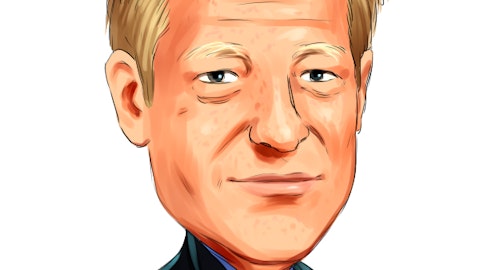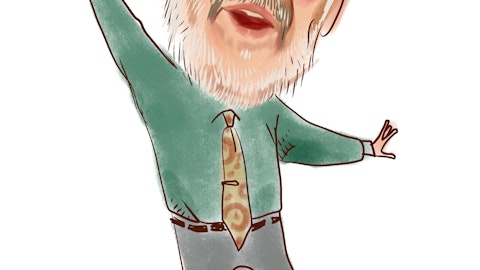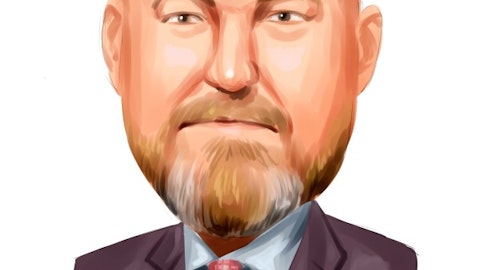The Bancorp, Inc. (NASDAQ:TBBK) Q4 2022 Earnings Call Transcript January 27, 2023
Operator: Good morning ladies and gentlemen and welcome to the Bancorp Inc.’s. Q4 and Fiscal 2022 Earnings Conference Call. This call is being recorded on Friday, January 27, 2023. I would now like to turn the conference over to Andres Viroslav. Please go ahead.
Andres Viroslav: Thank you, operator. Good morning and thank you for joining us today for the Bancorp’s fourth quarter and fiscal 2022 financial results conference call. On the call with me today are Damian Kozlowski, Chief Executive Officer; and Paul Frenkiel, our Chief Financial Officer. This morning’s call is being webcast on our website at www.thebancorp.com. There will be a replay of the call available via webcast on our website beginning at approximately 12:00 P.M. Eastern Time today. The dial-in for the replay is 1-877-674-7070 with a confirmation code of 735961. Before I turn the call over to Damian, I would like to remind everyone that when used in this conference call, the words believes, anticipates, expects and similar expressions are intended to identify forward-looking statements within the meaning of the Private Securities Litigation Reform Act of 1995.
Such statements are subject to risks and uncertainties which could cause actual results, performance or achievements to differ materially from those anticipated or suggested by such statements. For further discussion of these risks and uncertainties, please see the Bancorp’s filings with the SEC. Listeners are cautioned not to place undue reliance on these forward-looking statements which speak only as of the date hereof. The Bancorp undertakes no obligation to publicly release the results of any revisions to forward-looking statements which may be made to reflect events or circumstances after the date hereof or to reflect the occurrence of unanticipated events. Now, I’d like to turn the call over to the Bancorp’s Chief Executive Officer, Damian Kozlowski.
Damian?
Damian Kozlowski: Thank you, Andres. Good morning, everyone. The Bancorp earned $0.71 a share in the fourth quarter, driven by 28% revenue growth, while expenses were approximately flat year-over-year. GDV, gross dollar volume, transaction growth accelerated to 30% year-over-year, driven by continued double-digit growth in most categories. Core loan growth which excludes loans previously generated for securitization, was 4% quarter-over-quarter, led by floating rate CRE multifamily with 12% growth. Year-over-year core loan growth was 45% with 168% growth in CRE multifamily, 22% growth in Institutional which includes SBLOC and IBLOC plus IRA financing and 14% growth in commercial which includes fleet leasing and SBA loans, excluding PPP loans.
Net interest margin grew dramatically quarter-over-quarter from 3.69% to 4.21% compared to 3.51% in the fourth quarter of 2021, driven by the impact of Federal Reserve rate hikes. Efficiency and productivity continues to be a key focus of management, with expenses approximately flat year-over-year. ROE rose significantly over prior periods to 24%. 2022 was another year of strategic and financial progress for the Bancorp. We continue to improve our ecosystem for our fintech partners while investing across our platform to improve functionality and efficiency in all business lines. 2023 should show continued financial and operational improvement with a focus on continued rigorous risk management and credit oversight. In addition, our focus in ’23 will be determining our next strategic steps as a company.

After having established exemplar performance, we are now turning our attention to major initiatives which will sustain profitability and growth as we approach the regulation II, Durbin balance sheet limit of $10 billion. We believe that TBBK’s unique capabilities can be monetized more broadly and that the $10 billion limit will not limit our ability to generate increased profitability. This incremental profitability will be generated from fees by distributing both assets and liabilities. GDV growth and the sale of unique technology services and other platforms that will drive sustained EPS growth and ROE. For 2023, we are confirming our guidance of $3.20 a share, not including the net impact of share buybacks of approximately $25 million a quarter or $100 million for full year.
We will update our guidance as we learn more in the coming months. However, we believe our guidance is attainable even, even with significant economic ambiguity and potential stress in the macro environment. I now turn the call over to Paul Frenkiel, our CFO, for more details on the fourth quarter and full year ’22.
Paul Frenkiel: Thank you, Damian. Return on assets and equity for Q4 2022 were respectively 2.1% and 24% compared to 1.7% and 17% in Q4 2021. These increases were significantly driven by a 47% increase in net interest income. In addition to the rate sensitivity of the majority of our lending lines of business, management has structured the balance sheet to benefit more from a normalized and higher interest rate environment. Accordingly, over a period of years, it is largely allowed as fixed rate investment portfolio to pay down while limited purchases were focused on variable rate instruments. Additionally, the rates on the majority of loans adjust more fully than deposits to Federal Reserve rate changes. Accordingly, in Q4 2022, the yield on interest-earning assets had increased to 5.9%, while the cost of deposits had increased to 1.7%.
These factors were also reflected in the 4.2% NIM in Q4 2022 which represented a significant increase over prior periods. The provision for credit losses was $2.8 million in Q4 2022 compared to $1.6 million in Q4 2021. The $2.8 million included an upward adjustment of approximately $900,000 in the qualitative economic factor in our CECL model which is forward-looking, to the extent that economic uncertainties resulted in the future, a reversal of that provision component would result. Conversely, deterioration in the economy could result in additional forward-looking provisions. Prepaid debit and other payment-related accounts are our largest funding source and the primary driver of noninterest income. Total fees and other payments income of $22 million in Q4 2022 increased 10% compared to Q4 2021.
Noninterest expense for Q4 2022 was $43 million which was comparable to Q4 2021, a decrease in legal reflecting the resolution of various matters and a decrease in salary expense offset increasing FDIC insurance and travel expense. Book value per share at quarter end increased 10% to $12.47 compared to $11.30 a year earlier, reflecting retained earnings, partially offset by fair value adjustments to the investment portfolio resulting from the higher rate environment. Quarterly share repurchases should continue to reduce shares outstanding. I will now turn the call back to Damian.
Damian Kozlowski: Thank you, Paul. Operator, could you open the line for questions?
See also 10 Dirt Cheap Stocks To Buy and 13 Cheap New Stocks To Buy.
Q&A Session
Follow Bancorp Inc. (NASDAQ:TBBK)
Follow Bancorp Inc. (NASDAQ:TBBK)
Operator: Will do. Your first question comes from Frank Schiraldi.
Frank Schiraldi: Wondering if you guys could — good strong quarter on GDV growth year-over-year. I guess, really, you have been guiding to something along these lines but just your thoughts on runway from here? And how much of that translates through to card fee income growth?
Damian Kozlowski: Yes. I think this was a very good, normalized quarter. We had the stimulus. We never gapped down and we’ve been building all year back to trend. So we had 1%, I think it was 5% and now we’re at 13%. I think you’re going to see this range, 12% to 15% GDV growth going forward this year. I think you’re going to see around 9%, 10%, maybe even 11% translation into fees year-over-year. And that was before — that was kind of the trend before the big stimulus bump. So very encouraging. When we look at our pipeline, we’ve got some real successes in corporate payments that have ramped up very quickly. So it looks like it’s going to be at that level. Hopefully, we’ll get a bit more but it looks like it’s going to be a strong year.
Frank Schiraldi: Great. And then just on loan growth, the SBLOC, IBLOC portfolio growth has slowed a little bit, certainly over the last couple of quarters. And I just wondered if you could talk about your outlook for growth in that portfolio?
Damian Kozlowski: Yes. That is what is likely to happen, what we’ve seen it before. When you get this rapid — I mean this is historic but I mean you get a rapid change in — on liquid borrowing so quickly that people get a little thicker shock. So it’s a little bit encouraging that we were only down 1% to be honest. And there were more payoffs but were offset by more originations. So that should, by the middle of the year when interest rates stop, people normalize and then you’ll get — people just not lending for needs rather than just lending for liquidity. So it won’t be — and we’re — obviously, we’re coming closer to that balance sheet limit. It won’t be — we won’t have like historic 20% growth but we’ll have some growth but it won’t be as dramatic as we previously had until things really normalize. Once they normalize, we’ll go back to the previous trend, likely.
Frank Schiraldi: Okay. And then finally, I just wondered if you could talk about things that you’re doing to protect margin here as we perhaps come to the peak of this rate cycle. And what sort of margin reaction do you expect if we get a rate cut or two at the end of 2023 or into 2024?
Damian Kozlowski: Yes. So as Paul was saying, we’ve totally opened our balance sheet to the variable side. And we thought there would be — this was more dramatic than we expected but we really thought there was going to be a rise — ultimately a rise in interest rates. But we’ve left and are pivoting very quickly. We have a project in place called Project Flex. So we’re going to put on a lot of fixed rate exposure. We have a fixed rate program now in our CRE business. We’re putting on more fixed rate exposure in our commercial business. And then we — once again, we haven’t bought a bond. One easy way to do it is simply to lock in forward rates through 3-, 5-, 7- and 10-year agency securities. So we’re very aware of the situation and we’re going to significantly lower the variable part of our balance sheet as we peak out at rates.


